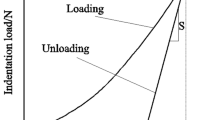Abstract
Tensile and fracture properties of molybdenum have been studied using the automated ball indentation technique. Tests have been carried out at several temperatures in the range of 148 to 423 K at a constant strain rate. Tensile properties determined from these tests agreed well with published results from conventional tensile tests. Temperature dependence of indentation energy to fracture, the fracture toughness parameter specific to this technique using critical stress-to-fracture concept, showed a sharp transition from brittle to ductile condition. These results complement the previous studies on pressure vessel steels, and clearly demonstrate that automated ball indentation technique is a reliable and non-destructive method for determining tensile and fracture properties of materials.
Similar content being viewed by others
References
F. M. Haggag, U.S. Patent no. 4,852,397 (1989).
F. M. Haggag and K. L. Murty, in "Proc. Non-destructive Evaluation and Materials Properties III,”"edited by P. K. Liaw et al. (TMS, 1997) p. 101.
F. M. Haggag, in "Small Specimen Test Technique Applied to Nuclear Reactor Vessel Thermal Annealing and Plant Life Extension, ASTM STP 1204,”"edited by W. R. Corwin, F. M. Haggag and W. L. Server (American Society for Testing and Materials, Philadelphia 1993) pp. 27–44.
F. M. Haggag and R. K. Nanstad, in "Innovative Approaches to Irradiation Damage and Failure Analysis,”"edited by D. L. Marriot et al. (ASME PVP 1989) Vol. 170, p. 41.
K. L. Murty and F. M. Haggag, “Investigation of Deformation Characteristics of Electronic Solders using a Novel Stress Strain-Microprobe (SSM): Application to Solder Aging and Life Prediction,”"Proceedings of InterPACK'97, ASME, EPP-Vol. 19–1, Advances in Electronic Packaging-1997, Vol. 1, pp. 1133–1139.
P. Q. Miraglia, MS thesis, North Carolina State University, 1997.
F. M. Haggag, Thak-Sang Byun, J. H. Hong, P. Q. Miraglia and K. L. Murty, Scripta Met. Mater. 38 (1998) 645.
D. Tabor, “The Hardness of Metals” (Oxford University Press, New York, 1951).
V. Tirupataiah and G. Sundararajan, Mater. Sci. Eng. 91 (1987) 169.
J. H. Underwood, G. P. O'hara and J. J. Zalinka, Experimental Mechanics 27 (1986) 379.
P. Bowen, S. G. Druce and J. F. Knott, Acta Metall. 35 (1987) 1735.
L. Northcott, “Molybdenum” (Butterworths Scientific Publication, 1956) p. 58.
Metals Handbook, Vol. 2 (American Society for Metals, 1978) p. 773.
R. O. Ritchie, W. L. Server and R. A. Wullaret, Met. Trans. 10A (1979) 1557.
Author information
Authors and Affiliations
Rights and permissions
About this article
Cite this article
Mathew, M.D., Murty, K.L. Non-destructive studies on tensile and fracture properties of molybdenum at low temperatures (148 to 423 K). Journal of Materials Science 34, 1497–1503 (1999). https://doi.org/10.1023/A:1004547709783
Issue Date:
DOI: https://doi.org/10.1023/A:1004547709783




